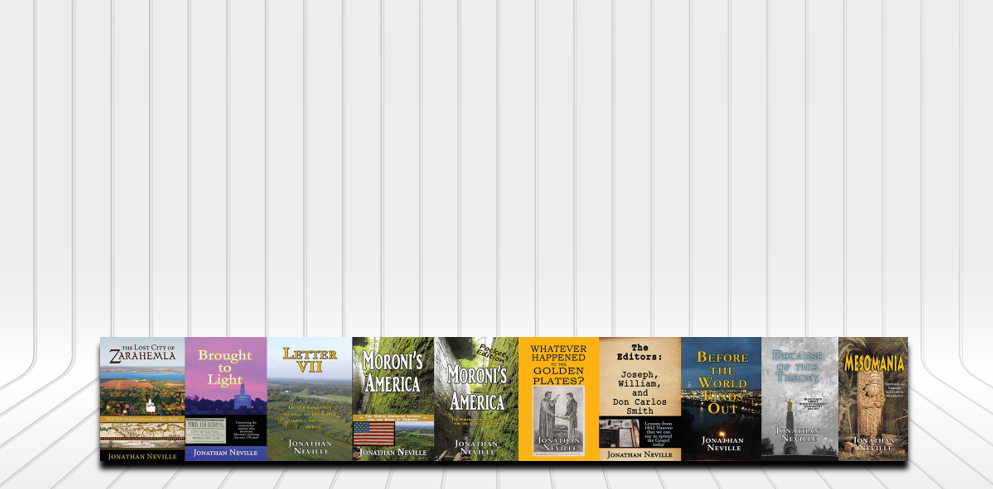Basic Geography
Book of Mormon geography can seem confusing. We read about and land and a city named Zarahemla. We read about a land and a hill named Cumorah. We read about a narrow neck, a narrow neck of land, a small neck of land, a narrow pass, a narrow passage, and a narrow strip of wilderness. Understanding Necks and Passes HERE
 How can we make sense out of all of this?
How can we make sense out of all of this?
The geography becomes more clear when we consult modern revelation. Cumorah is in New York (D&C 128). Zarahemla is in Iowa (D&C 125). The land occupied by the Nephites is north of the Ohio River. The land occupied by the Lamanites is south of the Ohio River. Everything else fits within this framework.
Cumorah Controversy
Many members of the Church are surprised to learn there is a controversy about the location of the Hill Cumorah. Most of us think it’s in New York, a few miles south of Palmyra. It’s obvious. Joseph got the plates there. The Jaredites and Nephites died there. Oliver Cowdery said that Mormon stood on this hill and surveyed the destruction of his people. Oliver’s description was published in three Church newspapers as Letter VII. Joseph Smith had it copied into his journal as part of his own history.
How could the Hill Cumorah not be in New York?
Believe it or not, some Book of Mormon scholars say the Hill Cumorah is not in New York. They insist the Hill Cumorah is in Central America! When they learn what these scholars teach, many LDS people become confused. Maybe you are, too. You might wonder, if Moroni buried the plates in New York, how could Cumorah be in Central America? The scholars have an explanation. They call it the “two-Cumorah” theory. They say there is one Cumorah in New York where Moroni buried the plates, and another Cumorah in Mexico where Mormon hid up all the Nephite records. The two-Cumorah theory flatly contradicts what Oliver Cowdery wrote.
 Moroni’s America Today
Moroni’s America Today
In 1936, when LDS scholars first began accepting the two-Cumorah theory, Apostle Joseph Fielding Smith warned the Saints. “Because of this theory,” he wrote, “some members of the Church have become confused and greatly disturbed in their faith in the Book of Mormon.” Twenty years later, as President of the Quorum of the Twelve, President Smith repeated the warning in his book, Doctrines of Salvation. The fact that the two-Cumorah theory has become the consensus among LDS scholars (and educators) is the reason everyone in the Church needs to read Letter VII.
 Scholarship
Scholarship
I want to emphasize that I have great respect for LDS scholars and educators, including those who focus on the Book of Mormon. They are faithful members of the Church. They work hard and follow accepted academic principles and practices. I’m not criticizing them personally or accusing them of anything untoward. In fact, on its face, the two-Cumorah theory is not irrational. It is the product of careful analysis of the Book of Mormon text. But as we’ll see, it has a major, devastating flaw.
 It rejects Letter VII. When Joseph Smith was alive, everyone knew that Cumorah was in New York. Letter VII was part of the first detailed Church history. Letter VII, written in 1835 by Oliver Cowdery with Joseph’s assistance, declares unambiguously that the final battles of the Nephites and Jaredites took place in the mile-wide valley west of the Hill Cumorah in New York.
It rejects Letter VII. When Joseph Smith was alive, everyone knew that Cumorah was in New York. Letter VII was part of the first detailed Church history. Letter VII, written in 1835 by Oliver Cowdery with Joseph’s assistance, declares unambiguously that the final battles of the Nephites and Jaredites took place in the mile-wide valley west of the Hill Cumorah in New York.
Oliver wrote: At about one mile west [of Cumorah] rises another ridge of less height, running parallel with the former, leaving a beautiful vale between. …when one reflects on the fact, that here, between these hills, the entire power and national strength of both the Jaredites and Nephites were destroyed. There is no ambiguity, hesitation, or speculation. Oliver declares that, in fact, the New York Cumorah is the site of the final battles. Letter VII was published in three Church newspapers in 1835-1841. Joseph included it in his journal. It was included in missionary pamphlets. While Joseph Smith was alive, no one questioned the New York setting. He referred to Cumorah in D&C 128. So how did we end up with a “two-Cumorah” theory that has become the consensus among LDS scholars and educators? Find out in the short book, Letter VII: Oliver Cowdery’s Message to the World about the Hill Cumorah, 2nd edition.
Click on the book to purchase hard copy or kindle. It’s also available at Deseret Book.
For some years, you could read the 1st edition for free at Book of Mormon Central HERE. I gave them permission to put the entire book on their website. However, Book of Mormon Central rejects the New York Cumorah, and the book proved too popular, so they removed it from their website.
You can read more about Letter VII on this blog:
You can also read Letter VII itself, without commentary or background explanation, from Joseph Smith’s history online at the Joseph Smith Papers. Click HERE
Moroni’s America Facebook Here









